Let’s face it. For most of the newsletters that we receive in our inbox, we hardly read them. Or if you’re seated in a waiting room for the doctor, you probably take a cursory glance at the magazine before placing it down and turning to your phone.
In November 2020, I started sitting down every Tuesday to write a Friday newsletter, with one sole intent.
To make my writing better, and to give a chance to feature the interesting people I met every week.
Since then, the newsletter has grown from a paltry 0, to 681 subscribers over 4 years. Whilst some of that has seemed slow, we’ve come to notice one thing.
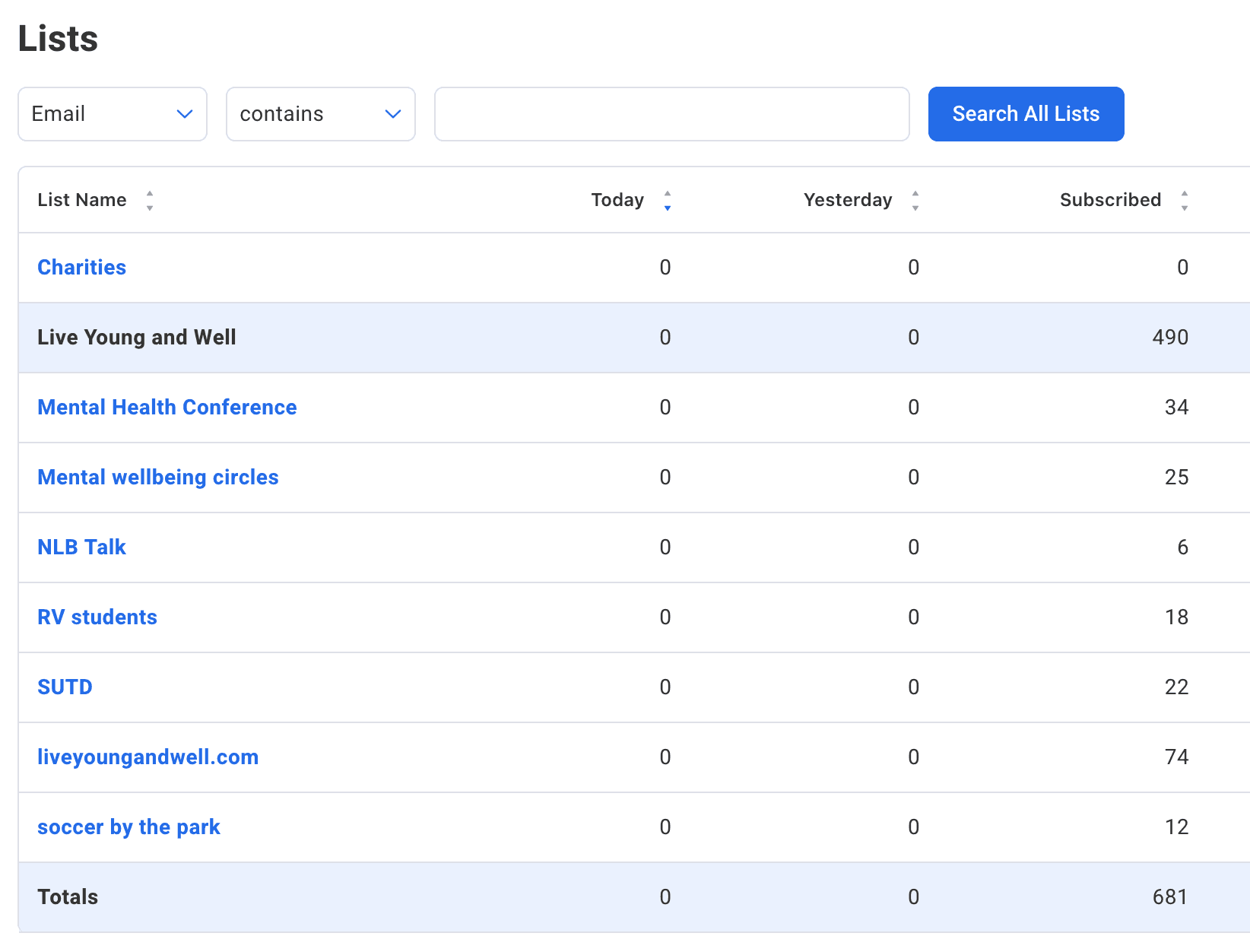
Slow is smooth, and smooth is fast.
Building an audience from scratch, and reading the personal thanks that come through when people write in, is touching.
And in December 2024, when we saw a town council put out a tender to do their electronic newsletters, we weren’t quite sure if they would choose us. We shared about our writing work as honestly as we could, and eventually they chose us.
But before that, we had to first ask the question,
Why were organisations like town councils even eager to send out email newsletters to residents?
Why send newsletters? To build trust.
If you doubt the power of newsletters, just look at Morning Brew, the newsletter that focused on business stories, and was sold for $75 million to Axel Springer in October 2020.
Over the years, if you look at the transition of how we consume content, it has moved from the doomscrolling on Facebook, to the personal stories we receive via Instagram, Whatsapp and Telegram, and now, to your personal electronic mailbox.
Say what you’d like, but we do know that there have been significant players in the US that have made big revenue gains through their email audience.
Just look at the likes of James Clear, who sold 20 million of his book Atomic Habits from his email newsletter. Or Shane Parrish of Farnam Street, who has built an entire venture capital business from starting his Farnam Street blog.

Yes, their articles have been written well, but one cannot deny the fact that they have simply blown the competition out of the water with their newfound stories, clean analyses, and deep insight.
If you look at why people buy their books and read their articles, it’s because they trust these writers, and are willing to follow what they preach.
It’s what we have tried to build ourselves, although we’ve not been close.
And the Town Council gave us a chance to start from a blank slate, and think about what was the best way to create content that people would want to read, and find helpful in their own journeys.
And that was when the hard work began. In the first month, we couldn’t quite figure out what was unique about the town council’s work. After all, if you’re not familiar with Town Councils, they handle municipal matters like trash disposal, cleaning of the void decks of apartment blocks, and much of that can seem unentertaining.
How might we make a town council interesting to people?
And how might you find an agency that would create newsletters that people want to read?
Raising the bar for content
The clearest way is by creating content that AI cannot create. For all the benefits of AI, AI still cannot go into the world, initiate conversations with people, and figure out where there might be interesting things to study.
It cannot understand where the pain points of readers are, although it can synthesize all the content on the web for you and come up with some pointers.
That’s why in assessing an agency, one of the most important things you should look at is its approach towards content building. Some key questions to ask is:
- Name me some of the articles you’re most proud of.
- Can you tell me some recent angles you’ve done?
- Talk me through a recent article you did and what you were proud of for that.
Find agencies led by journalist-like owners
However, for agencies who can answer your questions above, they need to have some background in journalism.
Recommendation 1: The Nutgraf – pricey, but professional
One of the better content agencies out there is our Worthy Rival – The Nutgraf. Led by 3 ex-Straits Times journalists, they have since become a powerhouse in producing quality content for organisations that want a trusted hand to steward their brand.
Seeing their work has been a major inspiration for us, as we have since learnt that to build good content, you have to be close to the ground.
But because they have done 10 years as an agency, and are led by ex-journalists, their prices do not start cheap. Expect it to be somewhere around 60k for 6 newsletters of 3 articles each.
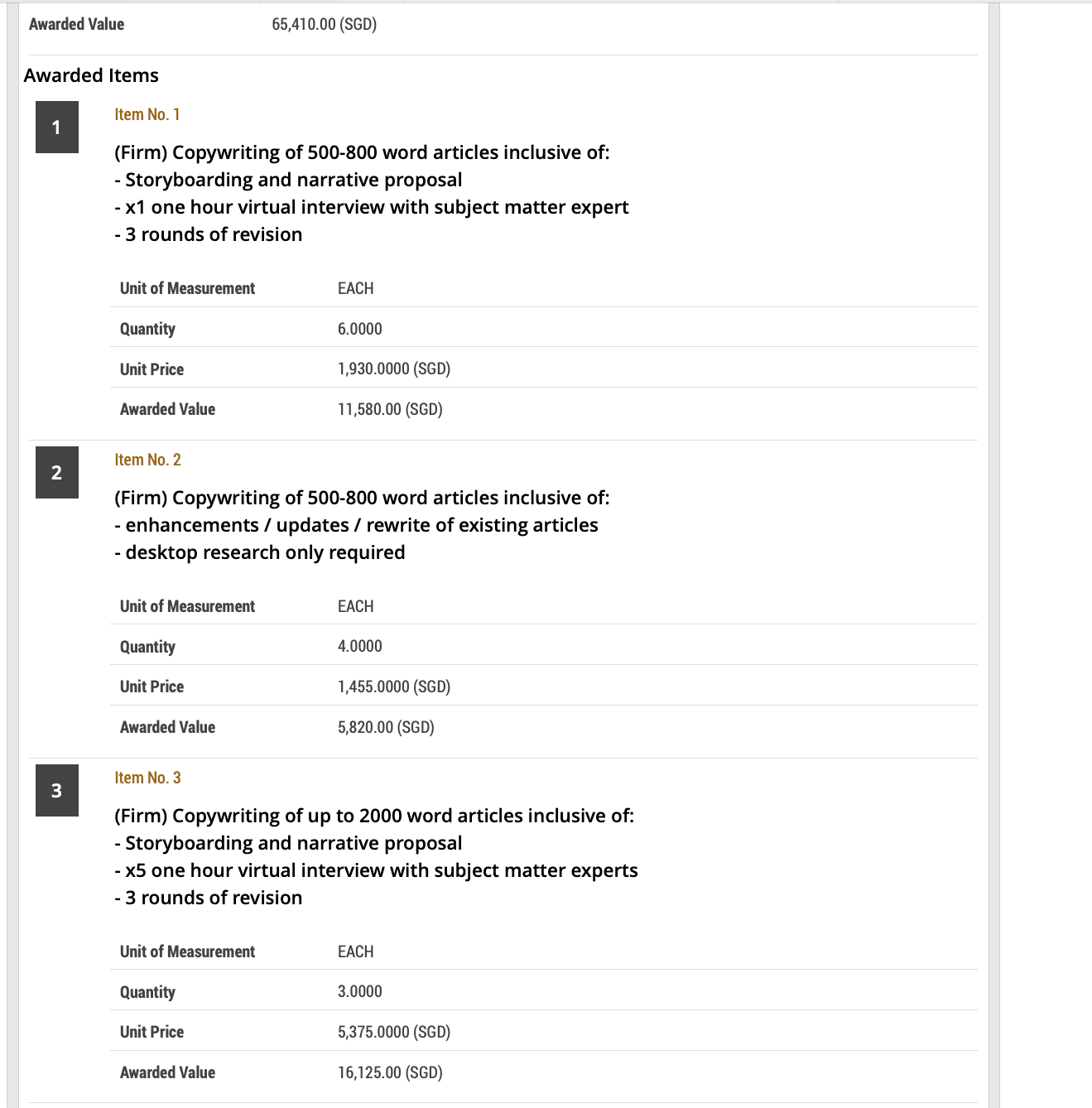
Recommendation 2: Media Lede (us) – value for money upstarts
For example, in our article for Tanjong Pagar Town Council, we covered the recent Budget 2025 Announcements. We became like residents ourselves, trying to understand what they would think, feel and do about the latest Budget goodies that the Finance Minister announced.
Within our own neighbourhood, I saw a chance ad on the digital display boards beside the lifts. It was about the Budget Meals Initiatives from GovTech and HDB, which listed the budget meals that citizens could find.
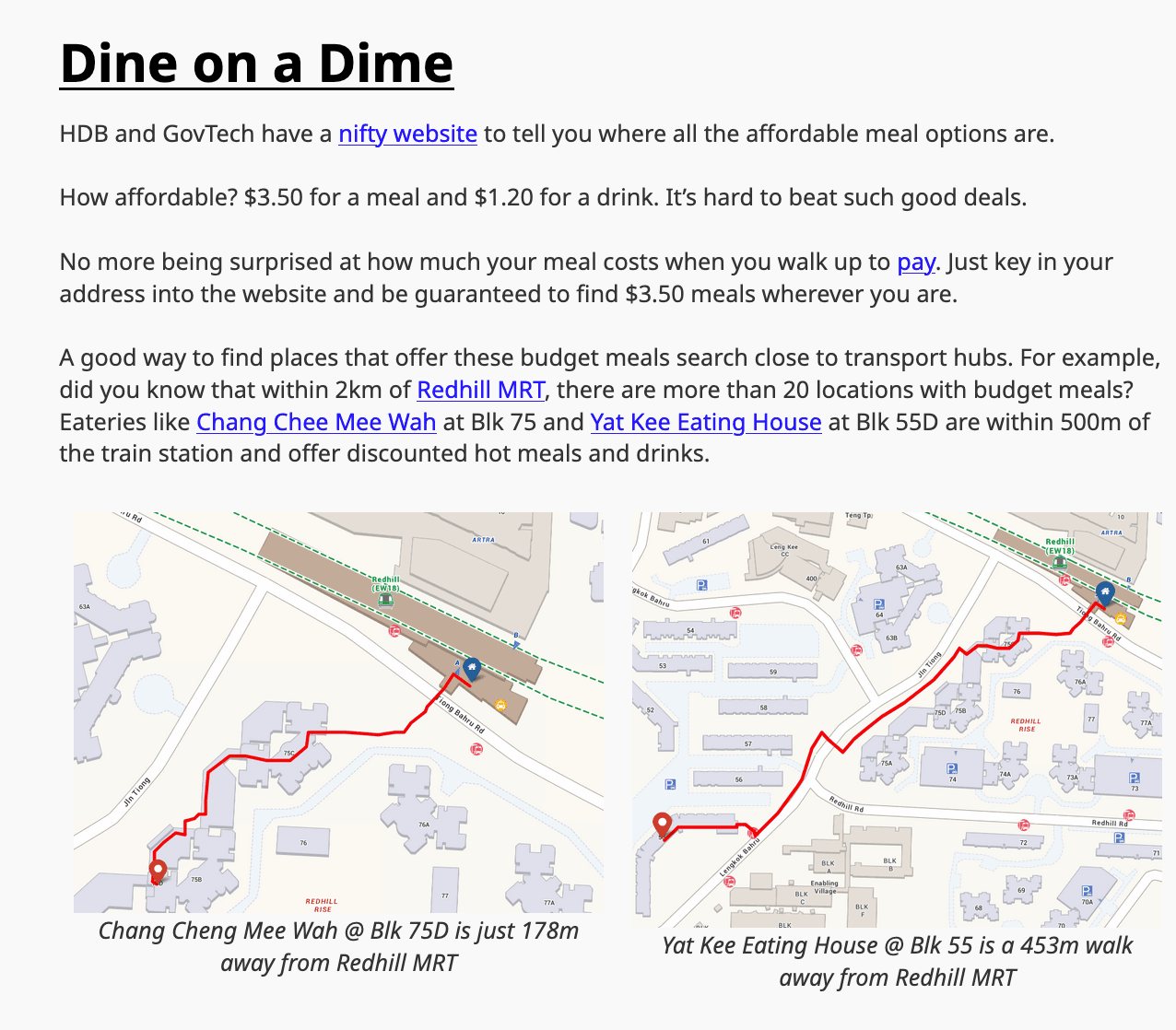
We included tips on where to find better value for money.
It became an article that participants found deeply helpful to find good, quality food, at affordable prices.
But as an agency, we’ve focused alot on practical storytelling as a way to create useful content.
The above newsletter article featured practical insights, but we also made sure that we included bits that would help people to emotionally resonate with the content.
We also knew that cost of living was something that was close to the hearts of many residents, with the Singapore Government also recognizing the pressures.
For example, PM Wong, in a 23 March visit to Kovan, said,
“We know cost of living is a big concern for residents, that’s why in this year’s Budget we have rolled out additional measures to help Singaporeans.”
In our article, we focused on something light-hearted and funny, such as searching for the ‘reduced to clear’ sections in supermarkets. This was something that we knew many would be familiar with, especially the bargain-hunters.

Find the agency that’s great at digging insights
Another article that has done particularly well has been a strange one. It’s on a covered walkway. You might think that this sounds boring, but what we found was that the entire process of how it went from an idea in the heads of the grassroots Advisors, to eventual execution, was something that interested the public.
To do this, we had to interview the Land Transport Authority staff that were on the ground, together with the contractors that were involved. How? Simply by being friendly and being curious.
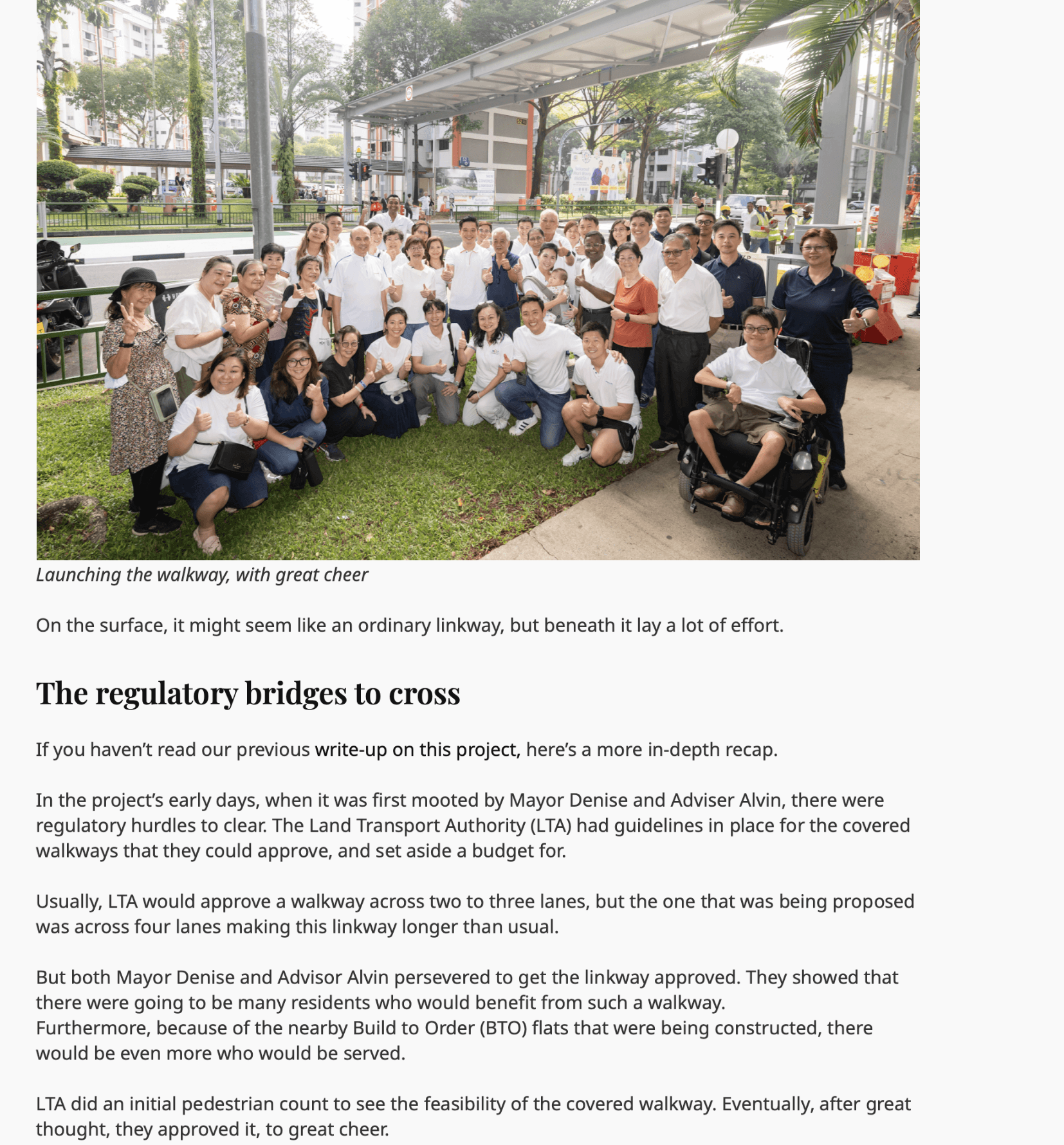
I bought a cup of iced coffee, and walked around, and tried to ask questions as politely as I could. And it worked. They let down their guard and slowly shared with us the hard work they had put in to make the walkway possible.
Look at the agency that does reader research
One of the most important things that we’ve done for the Town Councils that we’ve worked with is reader research. Whilst some of it can be difficult, we’ve found that there is no other better way to gather insights than to reach out to readers, and to get their feedback.
One of the reader surveys we did recently had an amazing number of feedback, with 73 readers responding. Even I was surprised. I had expected 10.
Yes, it would definitely cost you some money to incentivise readers to reply.
But when you read their live comments and feedback, you’d be surprised to just find what they want.
When I started writing for the town council, I used to think that they would prefer to hear about the latest fitness corners. But I now know that they would much prefer the food havens, and the local businesses they could support.
Having that insight up close is simply impossible to replicate.
Pick the agency that has their own newsletter
Perhaps the biggest indicator of our credibility was the fact that we were running a newsletter. Whilst it was a small number at 681, it was still a significant number. And the fact that we had run it for 4 years, sending it out weekly, meant that there was a lot of experience with figuring out what worked, and didn’t.
I started with a newsletter audience of 0. I confess. I was even scraping the emails of my friends from university, and adding them to the list, whether or not they had agreed. I broke the first rule of email marketing – permission-based marketing.
I soon saw the people leave, just as soon as they had been added.
In my inexperience I also sent newsletters that were very much focused on my own personal experience, even though few of these newsletter audiences knew me beyond an online persona.
Hearing feedback from my friend, who said he’d have preferred to hear those in person, rather than from an impersonal newsletter, made it clear to me that I needed to have stories that were also culled from beyond my personal repertoire of experiences.
Those 200 odd newsletters I’ve sent over the past 4 years, meant that in terms of experience, it was impossible to match.
Seeing open rates, having a handle over the percentages to expect, knowing intuitively whether a headline would work, sensing which stories would resonate, all of these have been hard won experience that cannot be easily replicated.
And it’s why organisations have continued to book us.
Recommendation 3: Ink and Pixel – Experts with big government players like LTA
Recently, as we were bidding for other projects, I chanced upon a project by the Land Transport Authority, asking for vendors to do up articles covering their work.
Whilst the articles are not exactly the most engaging, they have done the job. Kudos to them for doing such a job, especially when the 15 train disruptions over the past 3 months have placed LTA in an unhealthy spotlight.
That said, their 24 month contract for these items does not look that cheap.
| List number | Scope of work | Cost |
|---|---|---|
| 1. | Research, copywriting, copyteditying and proofreading of content Design of graphic design elements | $48,200 |
| 2. | Contest management | $15,600 |
| 3. | Strategic review of Connect newsletter | $5500 Total: $69,300 |
Especially when you look at the lowest bid that came in at about $30,000.
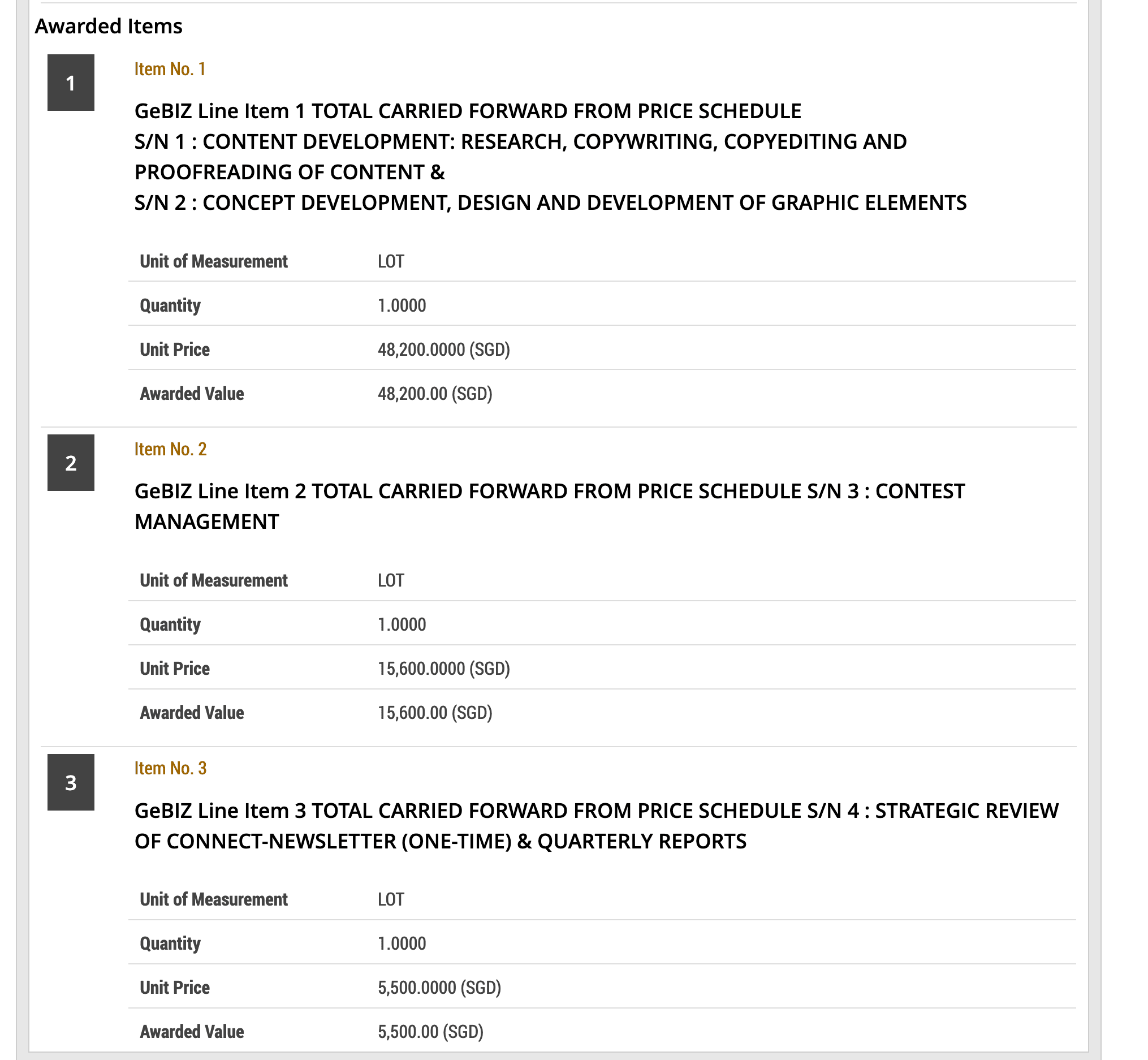
Choose the agency that you trust
At the end of the day, we’re not going to lie. Choosing an agency that you trust will be one of the hardest decisions, but also one of the most important ones.
When we’ve read the thanks that comes through from the readers that subscribe to our newsletter, it makes it all the more worthwhile. Because they do not just read.
They now remember what they’ve read, and they relate with you, the writer.
